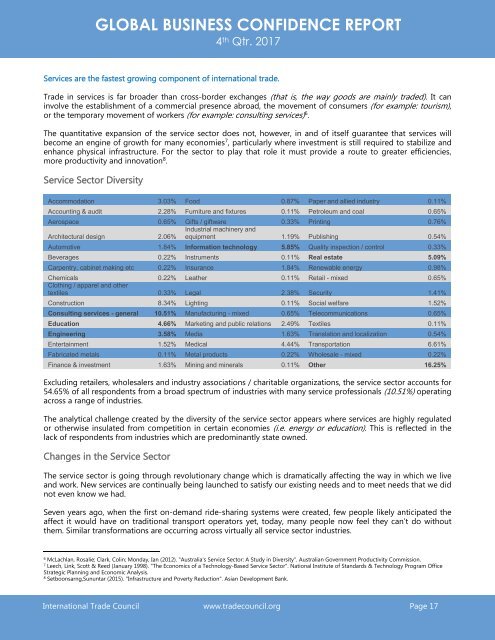2017 4th Quarter International Trade Council Global Business Confidence Survey
The Global Business Confidence Survey is designed to take the pulse of companies and sectors and reports on the conditions for businesses like yours. It offers valuable insights into trends of US and global business confidence by surveying people from across a broad spectrum of industries. The survey draws information from a range of sectors about current and historical business growth trends, efficiency, employment, regulation and other conditions affecting industry. Key users of statistical data include government agencies, trade bodies, chambers of commerce and academic researchers. This survey report was produced by the International Trade Council (http://www.tradecouncil.org | http://www.itcapproved.org).
The Global Business Confidence Survey is designed to take the pulse of companies and sectors and reports on the conditions for businesses like yours. It offers valuable insights into trends of US and global business confidence by surveying people from across a broad spectrum of industries. The survey draws information from a range of sectors about current and historical business growth trends, efficiency, employment, regulation and other conditions affecting industry.
Key users of statistical data include government agencies, trade bodies, chambers of commerce and academic researchers. This survey report was produced by the International Trade Council (http://www.tradecouncil.org | http://www.itcapproved.org).
You also want an ePaper? Increase the reach of your titles
YUMPU automatically turns print PDFs into web optimized ePapers that Google loves.
GLOBAL BUSINESS CONFIDENCE REPORT<br />
4 th Qtr. <strong>2017</strong><br />
Services are the fastest growing component of international trade.<br />
<strong>Trade</strong> in services is far broader than cross-border exchanges (that is, the way goods are mainly traded). It can<br />
involve the establishment of a commercial presence abroad, the movement of consumers (for example: tourism),<br />
or the temporary movement of workers (for example: consulting services) 6 .<br />
The quantitative expansion of the service sector does not, however, in and of itself guarantee that services will<br />
become an engine of growth for many economies 7 , particularly where investment is still required to stabilize and<br />
enhance physical infrastructure. For the sector to play that role it must provide a route to greater efficiencies,<br />
more productivity and innovation 8 .<br />
Service Sector Diversity<br />
Accommodation 3.03% Food 0.87% Paper and allied industry 0.11%<br />
Accounting & audit 2.28% Furniture and fixtures 0.11% Petroleum and coal 0.65%<br />
Aerospace 0.65% Gifts / giftware 0.33% Printing 0.76%<br />
Industrial machinery and<br />
Architectural design 2.06% equipment 1.19% Publishing 0.54%<br />
Automotive 1.84% Information technology 5.85% Quality inspection / control 0.33%<br />
Beverages 0.22% Instruments 0.11% Real estate 5.09%<br />
Carpentry, cabinet making etc 0.22% Insurance 1.84% Renewable energy 0.98%<br />
Chemicals 0.22% Leather 0.11% Retail - mixed 0.65%<br />
Clothing / apparel and other<br />
textiles 0.33% Legal 2.38% Security 1.41%<br />
Construction 8.34% Lighting 0.11% Social welfare 1.52%<br />
Consulting services - general 10.51% Manufacturing - mixed 0.65% Telecommunications 0.65%<br />
Education 4.66% Marketing and public relations 2.49% Textiles 0.11%<br />
Engineering 3.58% Media 1.63% Translation and localization 0.54%<br />
Entertainment 1.52% Medical 4.44% Transportation 6.61%<br />
Fabricated metals 0.11% Metal products 0.22% Wholesale - mixed 0.22%<br />
Finance & investment 1.63% Mining and minerals 0.11% Other 16.25%<br />
Excluding retailers, wholesalers and industry associations / charitable organizations, the service sector accounts for<br />
54.65% of all respondents from a broad spectrum of industries with many service professionals (10.51%) operating<br />
across a range of industries.<br />
The analytical challenge created by the diversity of the service sector appears where services are highly regulated<br />
or otherwise insulated from competition in certain economies (i.e. energy or education). This is reflected in the<br />
lack of respondents from industries which are predominantly state owned.<br />
Changes in the Service Sector<br />
The service sector is going through revolutionary change which is dramatically affecting the way in which we live<br />
and work. New services are continually being launched to satisfy our existing needs and to meet needs that we did<br />
not even know we had.<br />
Seven years ago, when the first on-demand ride-sharing systems were created, few people likely anticipated the<br />
affect it would have on traditional transport operators yet, today, many people now feel they can’t do without<br />
them. Similar transformations are occurring across virtually all service sector industries.<br />
6<br />
McLachlan, Rosalie; Clark, Colin; Monday, Ian (2012). "Australia's Service Sector: A Study in Diversity". Australian Government Productivity Commission.<br />
7<br />
Leech, Link, Scott & Reed (January 1998). "The Economics of a Technology-Based Service Sector". National Institute of Standards & Technology Program Office<br />
Strategic Planning and Economic Analysis.<br />
8<br />
Setboonsarng,Sununtar (2015). "Infrastructure and Poverty Reduction". Asian Development Bank.<br />
<strong>International</strong> <strong>Trade</strong> <strong>Council</strong> www.tradecouncil.org Page 17


